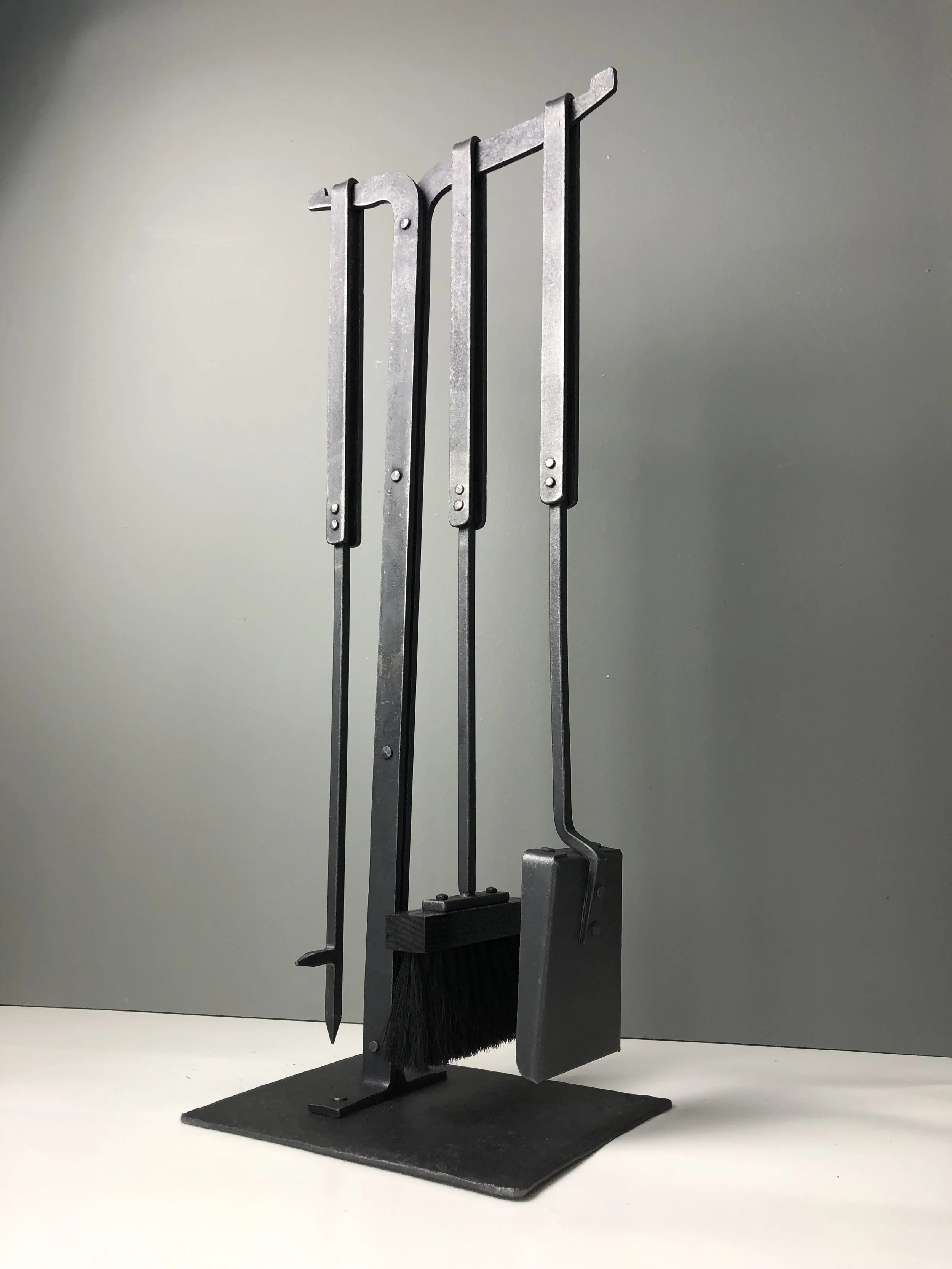On Labour, Liberty and Art in the Work of Oluseye
Oluseye Ogunlesi in the studio, 2023. Photo: Michael Duong. Courtesy of the artist.
One of the enduring features of Black life in Canada centres around how labour — often invisible or perhaps forgotten — is intertwined with identity. So often, such experiences are kept alive through memories and oral histories that offer paths to imagined futures. These experiences are also part of our material surroundings, which often contain beliefs, stories, myths, hopes and dreams.
These are some of the ideas taken up by Nigerian-Canadian artist Oluseye Ogunlesi (he uses the mononym Oluseye), whose work stems from the oral histories collected through his travels. Oluseye’s assemblages imbue everyday objects with cultural complexity, historical authenticity and significance.
Oluseye was born in London, United Kingdom, to Nigerian parents. He studied commerce at McGill University and received a master’s degree in entrepreneurship from the Bayes Business School in London, but did not receive formal training in art. As an artist working very much independently, with career stints in public relations and as a booking agent for creative talent, Oluseye has been noticeably successful in using social media and attendant media coverage to raise his own profile as an emerging artist, one who has taken a non-traditional path that has provided a global and nonlinear outlook on the art world. His work, which includes assemblage, painting, photography and sculpture, was publicly shown for the first time in the Art Gallery of Ontario’s Scratch & Mix Project exhibition in 2015.
Oluseye’s Eminado series (2018-ongoing) collects what he refers to as “diasporic debris”: found objects that include pieces of rubber, cowrie shells, electrical parts and other items that are laden with stories and lived experience, sometimes becoming talismans through his artistic process. This carefully gathered and present collection of objects invites the viewer to consider the Black Atlantic — that physical and imagined space that triangulates diasporic histories and cultures related to West Africa, North America and the Caribbean, and Europe — as being both metaphysical and existing beyond time. Rather than being reduced to historical artifacts, in Oluseye’s hands, the collected fragments have plenty to say about our past and present, simultaneously pointing to what is yet to unfold.
Oluseye Ogunlesi, Ploughing Liberty, 2021. Found farm tools, hockey sticks and brass dowels. Photo: Toni Hafkensheid. Courtesy of the artist.
In Ploughing Liberty (2021), exhibited at Greater Toronto Art 2021 at Museum of Contemporary Art Toronto, Oluseye presents a series of wall-mounted sculptures inspired by conversations he had with the late Ms. Myrna, a well-respected elder who shared stories of the history of North Preston, a community just outside of Dartmouth, N.S. As descendants of Jamaican Maroons who fought the British for freedom and were consequently deported to Canada against their will, her ancestors were promised land by the Crown which never materialized. Instead, they endured hard labour and segregation, along with Black Loyalists who settled in Canada after fighting alongside the British in the American Revolution — racial injustices that have left an imprint on Black Nova Scotians to this day.
In its resonant engagement with Canadian history and Black labour, Ploughing Liberty powerfully evokes the ongoing complications found within the word nation. As provocative hybrid forms, Oluseye’s sculptures make visible what is too often forgotten or overlooked, namely that ideas of belonging and exclusion, labour and leisure, and pleasure and pain, are often deeply interconnected and indivisible. The sculptures challenge the viewer to think anew about what is past and present, and poignantly remind us of stories that are as enduring as the land itself.
Drawing from this history, Oluseye’s sculptures are constructed with antique farm tools sourced from the United States, Nova Scotia and Ontario, and fused with discarded ice hockey sticks found in his Toronto neighbourhood. The implements were mostly procured from the European settlers who live in places where generations of Black labourers once tilled the soil.
The duality of the sculptures signifies tensions related to Black labour, belonging, economic viability, history, exclusion and perseverance, evoking histories of Black migration, particularly the successive waves comprising Loyalists, Jamaican Maroons and fugitive slaves who moved to Nova Scotia, Ontario and other parts of the U.S. in the late 18th century. Through the inclusion of hockey sticks, they also allude to Canada’s white-settler state-making and iconography, as well as leisure and sport.
The artwork consists of 20 wall-mounted sculptures arranged vertically in small groupings. The works cast shadows, a visual haunting that conjures the past. The wooden handles have been hollowed out to allow for the careful encasement of hockey stick shafts, leading to the poignancy of Black labour making possible white pleasure. The sculptures offer ways for us to think about how Black labour has contributed to the Canadian nation-state, while white people have claimed hockey as a national pastime rooted in leisure, one often denied to Black people.
Oluseye’s artworks, individually and collectively, present tensions rooted in contradiction, signifying histories and experiences that are parallel yet opposing. They force us to reckon with a twinned reality: Blackness and whiteness are self-referring poles which are co-constructed and impact our notion of place and space. Hockey becomes a site where Black presences have been elided, leaving the false impression that our presences have been insignificant. As Katherine McKittrick has argued, it is national spaces and sites like hockey that have “incorrectly deemed black populations and their attendant geographies as ‘ungeographic’ and/or philosophically undeveloped”. [1]
Close inspection of the sculptures reveals the traces of use in the wood. These imperfections appear as historical repositories, or precise markers of bygone labour and play. The places on the farming tools where the handles appear slim denote wear; the work of hands making wood smooth. The viewer is left with an impression of the person who might have struck soil with a hoe, who might have dragged soil with a rake. Oluseye made the pieces, inspired by one of Ms. Myrna’s stories.
“She told me that her ancestors were essentially forced to dig their own graves through their labour, which didn’t yield a better life. When I look at those tools, I connect with that history, with the people who would have used them.”
The same can be said of the hockey sticks. What might that cracked shaft say about the way a player handled the stick during a game? What does the chipped blade suggest about the amount of times it was slammed into ice?
With the sculptures, Oluseye also draws from the contemporary experiences of present-day agricultural workers from the Caribbean and Latin America related to this history of labour and extraction, showing how labour on Ontario’s farms, where close to 27,000 temporary foreign workers were employed in 2021, present a continuity with the past.
Oluseye’s work also reminds us of how Black labour continues to underpin our capitalist economic order. The physicality of the tools, their undeniable solidity, brings to mind all the ways in which colonization has turned blood, sweat and tears into commodity and commerce. It brings to mind “thingification” — Aimé Césaire’s term for the dehumanizing process Black people — who were considered commodities during slavery — have undergone since the trans-Atlantic slave trade. [2]
The sculptures reflect the social and economic inequities that perpetually trap Black people near the bottom of indices of wealth and health. Oluseye’s engagement with the project of Black visibility captures a hard truth about life in Canada. “I think of the hybrid works representing a problem with the notion of social mobility and progress,” says Oluseye. “On the one hand, you have the hard, rugged tools and their associated labour, and then, with hockey, you have ideas of leisure, and the relative smoothness of ice. In this contrast, I’m reminded of the hopes of moving from hardship toward a better life, which often go unrealized.”
Ploughing Liberty surfaces and probes several fissures that run through ideas concerning Blackness and belonging. The work provokes us to think deeply about the contradictions of Black presence in the Canadian settler state. Oluseye’s sculptures do the work of addressing the ways in which Black people have been denied acceptance into the idea of the nation-state, or the fabric of the Canadian identity.
The artist has pointed out how he contemplated Maslow’s hierarchy of needs when making the sculptures, as he created work that “signalled Black people’s continued struggle to make their way toward necessities — while others move toward self-actualization through creativity and sport.”
This is a diasporic work that complicates the notion of nation. In their fused rendering, the sculptures trouble any hopes for segregation: we cannot hope to see our racial and cultural differences as being entirely distinct or disconnected. These sculptures embody the differences that are symbiotically forged and maintained, leading to profound questions. In this state of manufactured co-existence, how do we as Black people grapple with our desire to both belong and escape?
[1] Katherine McKittrick, Demonic Grounds: Black Women and the Cartographies of Struggle (Minneapolis: University of Minnesota Press, 2006), xiii.
[2] Aimé Césaire, Discourse on Colonialism, trans. Joan Pinkham (New York: Monthly Review Press), 21. Originally published as Discours sur le colonialisme (France: Présence Africaine, 1955).
This article was originally published in the Spring/Summer 2023 issue of Studio Magazine.









